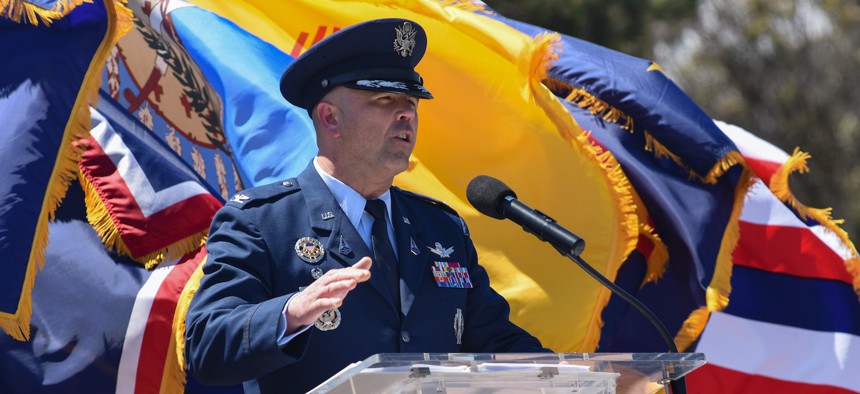
Brig. Gen. Anthony Mastalir at a base renaming ceremony in 2021. U.S. Space Force / Michael Peterson
Space Force Is Setting Up Inside Combatant Commands
INDOPACOM is the first warfighting command to stand up a USSF component, but it won’t be the last.
Catching up to its sister services, U.S. Space Force is starting to open coordination offices in the regional commands that run military operations and fight wars.
The first of these stood up on Tuesday in Hawaii, where Brig. Gen. Anthony Mastalir assumed command of the Space Force component of U.S. Indo-Pacific Command. The component is the service's first permanent presence outside the continental United States and will be staffed by 21 military and civilian personnel, Gen. David Thompson, the vice chief of space operations, told reporters.
The mostly organizational move gives the Space Force a direct line to Adm. John Aquilino, commander of the U.S. Indo-Pacific Command, and involvement for discussions that were previously filtered through the Air Force, Thompson said.
The new component will help coordinate and synthesize space offerings from commercial companies, the intelligence community, National Reconnaissance Office, and allies and partners for INDOPACOM.
This new set of space experts is also expected to improve the processes that combatant commands have to identify their most urgent and emergent operational needs. Thompson said their support will help integrate space capabilities with air forces, maritime forces with the Navy with the Marine Corps, and the Army.
Component guardians will support operating GPS and satellite communications constellations as well as monitoring areas for missile detection, launch and tracking for the command, partners, and allies.
Space capabilities will help with navigation, communications, missile tracking and detection, intelligence, surveillance, and reconnaissance, and strategic command and control for nuclear forces.
“All of those capabilities are vital,” Thompson. “And I wouldn't want to decide that one of them's more vital than the other, but I will say without any one of them, our forces are at risk.”
The new component is part of an increased national security and defense focus on China. The Air Force has been experimenting with next generation fighters and working to shore up its cybersecurity in the region.
Thompson said the Space Force chose to expand first in the Indo-Pacific to emphasize its continued focus: “We very deliberately chose first because…that's what we pay attention to every single day.”
Additionally, similar components are expected to come online in 2023. The Air Force has greenlit additional space components in Korea, Central Command, and European Command to take shape in the coming year. The first two will come “relatively soon,” the general said.




